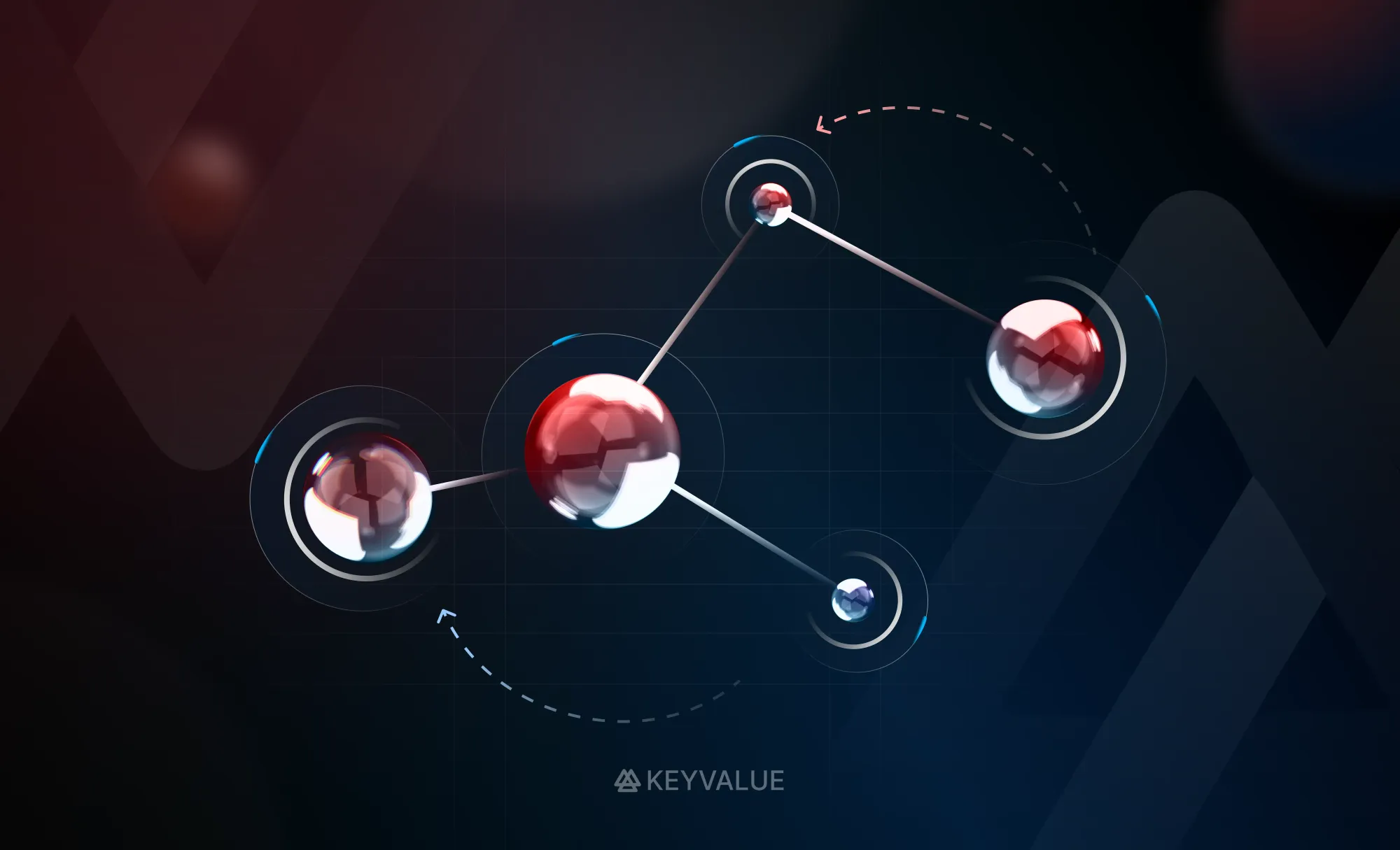
Highlights
- LangChain helped us get started with AI application development, but its agent-based flexibility became difficult to control as workflows expanded.
- LangGraph introduced structure, state management, and clarity to our multi-agent workflows, improving scalability and predictability.
- This blog shares how the KeyValue team made the shift from LangChain to LangGraph and the lessons we learned while building real AI systems.
When we first started building our AI-powered system, everything felt simple. The goal was to process natural language prompts, extract relevant details, and perform the right actions. At that stage, the complexity was low, and integrating APIs and managing interactions seemed straightforward.
For our first version, we chose LangChain, a widely adopted framework for AI application development. It simplified the process of connecting large language models (LLMs) with external tools and services. LangChain’s agent-based approach and built-in tool calling made it easy to interpret user intent and execute actions.
Our early experience was smooth. We could take user inputs, understand their purpose, and trigger the right endpoints efficiently. At that time, LangChain seemed like the perfect foundation for our AI system.
Where LangChain started to falter
As with any evolving system, our initial problem space began to expand. New requirements emerged, demanding additional functionality such as:
- Managing multi-step AI workflows
- Retaining context across multiple interactions
- Handling conflicting requests intelligently
- Executing structured decision-making without ambiguity
- Ensuring predictable execution of tool calls
The more we refined our LangChain implementation, the less predictable it became. The agentic nature of LangChain, designed for flexible reasoning, started turning into a challenge as we introduced structured workflows.
Some of the biggest pain points included:
- Inconsistent tool execution: The agent often struggled to call the correct tool at the right time, leading to unpredictable behavior.
- Lack of state persistence: Managing user intent over multiple interactions became unreliable and required heavy prompt engineering to maintain context.
- Ambiguity in decision-making: Since LangChain’s agent-driven model relied heavily on LLM reasoning, controlling execution order and logic flow became difficult.
- Scalability concerns: As more features were added, debugging and maintaining the AI agent’s behavior became increasingly complex.
Despite our efforts—prompt fine-tuning, constraining tool usage, and defining reasoning paths—the unpredictability persisted. We were no longer building a structured system; we were managing an agent that was difficult to control.
How LangGraph brought structure and predictability to our AI workflows
The need for structure, determinism, and reliable state management led us to explore LangGraph, a framework designed for orchestrating workflows with clear state transitions. Unlike LangChain’s agent-centric model that lets LLMs decide their next step dynamically, LangGraph introduces explicit control over the execution flow.
Here’s why LangGraph immediately stood out for our AI application development needs:
- Deterministic execution: Instead of relying on an agent to decide what to do next, we could now predefine state transitions and ensure predictable outcomes.
- Better state management: With built-in mechanisms to persist context across multiple interactions, the system could now understand and process multi-step workflows more reliably.
- Structured multi-agent capabilities: LangGraph enabled the use of specialized sub-agents for distinct tasks, improving both modularity and maintainability.
- Transparent debugging: The explicit workflow structure made it significantly easier to trace failures, identify logic gaps, and optimize the system.
The change was noticeable from day one. Our workflows became more consistent, debugging turned simpler, and every process followed a clear logic path that the team could visualize and adjust easily.
Scale AI Systems with Structure and Precision
If you’re designing AI workflows that need reliability, structure, and control, it might be time to move beyond agent-driven frameworks. KeyValue helps teams adopt cutting-edge technologies to build scalable, state-driven systems that deliver consistent results in real-world environments. Let’s talk about your next AI workflow.
Challenges in migrating to LangGraph
The transition to LangGraph was not without challenges. Since the framework was relatively new at the time, documentation and community examples were limited. We had to rely heavily on experimentation and testing to adapt our system.
Moving from LangChain’s flexible reasoning model to LangGraph’s structured orchestration required a complete shift in mindset. Our team had to start thinking in terms of state-driven workflows instead of reactive agents. Designing transitions, mapping task dependencies, and defining clear states demanded extra effort in the initial stages.
Some of the key challenges included:
- Lack of documentation and examples: We had to learn through trial and error and validate our assumptions with each iteration.
- Mindset shift: Moving from agent-based reasoning to deterministic state management took time for developers to fully adapt.
- Refactoring workflows: Existing LangChain-based logic needed to be redesigned to fit LangGraph’s node-based orchestration model.
However, once the learning curve flattened, the benefits became evident. The system became more predictable, scalable, and resilient. We could add new functionality without destabilizing existing modules, and debugging was no longer a guessing game.
LangChain vs LangGraph: The turning point in our AI workflow design
When we started experimenting with LangGraph, it became clear that the difference between the two frameworks was not just technical but philosophical.LangChain focused on dynamic reasoning and agent autonomy, while LangGraph prioritized structured execution and predictable results.
Here’s a quick comparison from our experience:
| Aspect | LangChain | LangGraph |
|---|---|---|
| Workflow Type | Agent-driven and flexible | State-driven and structured |
| Execution | Dynamic, based on LLM reasoning | Deterministic, defined by state transitions |
| Context Handling | Limited persistence, depends on prompt engineering | Built-in state management across steps |
| Debugging | Complex due to agent unpredictability | Transparent and traceable |
| Scalability | Challenging as workflows grow | Easier to maintain and expand |
| Ideal Use Case | Fast prototyping, exploratory AI systems | Scalable, production-grade AI workflows |
Key takeaways: When to choose LangGraph over LangChain
Both LangChain and LangGraph are powerful frameworks for AI application development, but their strengths lie in different areas. LangChain offers flexibility for quick prototyping, while LangGraph provides structure and control for scalable, production-ready systems.
From our experience at KeyValue, LangGraph becomes the better choice when workflows demand:
- Structured decision-making: You need a clear logic flow with defined transitions.
- Reliable state management: The system must retain context across multiple interactions.
- Multi-step task orchestration: Complex processes need to be broken into smaller, manageable states.
- Scalability with control: Growth should not come at the cost of unpredictable behavior.
For us, the shift was not just about changing frameworks; it was about adapting to complexity with the right tool. LangGraph allowed us to design predictable, maintainable systems where every action had a clear cause and effect.
What’s new in AI orchestration: Beyond LangChain and LangGraph
AI orchestration frameworks continue to evolve beyond LangChain and LangGraph. A few notable developments shaping 2025 include:
- Federation of Agents (FoA): A new decentralized orchestration approach where multiple AI agents collaborate dynamically, improving scalability across complex systems.
- OpenAI Agents SDK and CrewAI: New frameworks offering modular, multi-agent coordination with better control and visualization.
- Trust-aware orchestration models: Research now focuses on improving reliability by letting orchestrators adjust agent behavior based on confidence scores.
Conclusion
Our journey from LangChain to LangGraph reshaped how we build and scale AI systems. What began as an effort to simplify development turned into a pursuit of structure, reliability, and control. LangGraph gave us the foundation to design AI workflows that are predictable, maintainable, and ready for real-world scale.
At KeyValue, we continue to explore how structured orchestration can make AI systems smarter and more dependable.
FAQs
1. How does LangGraph make AI workflow development more reliable?
LangGraph provides a structured, state-driven framework for building AI workflows. It ensures deterministic execution, better state management, and transparency in debugging, making large-scale systems more predictable and easier to maintain.
2. What’s the difference between LangChain and LangGraph?
LangChain focuses on agent-driven flexibility and dynamic reasoning, while LangGraph emphasizes structured orchestration and clear state transitions. In practice, LangGraph offers more control and reliability for complex, production-ready workflows.
3. Is LangGraph still relevant?
Yes. LangGraph remains one of the most reliable open-source frameworks for structured AI orchestration. It continues to evolve alongside new agent frameworks, making it relevant for scalable, stateful AI systems.
4. What is the difference between LangSmith and LangGraph?
LangSmith is primarily a debugging and monitoring tool that works with frameworks like LangChain and LangGraph. LangGraph, on the other hand, is a workflow orchestration framework designed to define, manage, and control AI execution flows.
5. What problems does LangGraph solve?
LangGraph addresses unpredictability, poor state management, and debugging complexity in AI workflows. It gives developers the ability to design deterministic, transparent, and scalable systems for real-world applications.


